ASIA 1989/1990 Part 2
India
(Click for India and Nepal map)I landed in Dum Dum Airport about 17.30 Calcutta time on 11 January. I could tell the difference from Thailand even before landing, the smoky grime of the industrial area visible from the plane.
A group of us, including Dutch and Israelis (good to bargain for fares) got into taxis for 10 Rp each (about 17 Rp to the USD) and negotiated the dark but still chaotic streets to the travellers ghetto of Sudder Street. Very little accommodation was to be found, its a cool 21 deg here and this is the height of the season. We even tossed up the idea of sleeping in the park, like the locals. But eventually 5 of us found a big but drab room to share, with sleeping mats on the floor; OK for one or two nights anyway. I went out for a dahl and chapati dinner and met a Dutch guy Twan, who worked at a Mother Theresa place and who I'd be spending quite a bit of time with in Calcutta.
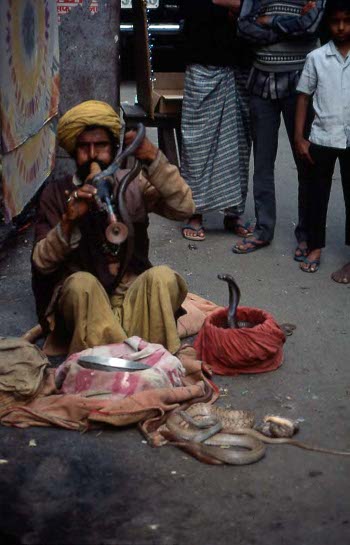
Snake Charmer, Calcutta
The city was slightly less squalid looking than in 1977, but the air was cough-inducingly smokey and polluted. Crowding, poverty and noise were as dominant as ever. We couldn't help but feel that maybe Calcutta is a taste of what the whole world might be like sometime in the future. The walk across the monstrous Howrah bridge (you can feel the girders vibrating underfoot) to the apocalyptic-like sea of humanity emanating from the Howrah train station, is an experience one must psychologically prepare for. At the end of a day in the shower my hair runs black from accumulated smoke. I worked out that breathing in this city must be equivalent to a pack a day.
I'd be in Calcutta a couple of weeks, mainly doing volunteer work, as a lot of travellers did, for one of the Mother Theresa refuges. It's a good way to get to know people, learn about the culture, and even have the illusion of doing good (I have a feeling that the volunteer work is more of a PR exercise than actual desperately-needed help). To do the work, one must register at the MT office, I think for security reasons and to overcome any suspicions that you're taking someone's job.
After a couple of days exploring the city and sightseeing, I was ready to start with Mother Theresa, at the Prem Dan refuge near Park Circus, about a half hour walk from my place. It's a disused factory converted into a refuge, catering to the sick, crippled and mentally handicapped. There are a lot of poor people hanging around outside the refuge, making me wonder how they decide who can get in and who can't. If you are one of the lucky ones, you do get well cared for inside.
The refuge was divided into a male and female section; we obviously worked with the men. The guests were mostly adults with a few children and adolescents; most children and infants are I think at the Kali Ghat facility. Most were crippled and/or retarded. Typically we would start work about 08.00 or so. First job was to bathe and dress the guests, not always easy owing to their varying degrees of lucidity and physical mobility, but not really difficult. Some had tuberculosis and other deformities. Some were very interesting to talk to, others were virtually incontinent vegetables. We were supervised and helped by staff members.
At about 10 am we all attended mass. At 11.00 to 12.30 we fed the guests, usually vegetables and rice with sometimes meat. Most would feed themselves but we had to feed some of the people by hand. We would then leave to go home for our own lunch. Not much went on in the afternoon; sometimes we came back to work, giving haircuts, talking to the people and feeding them about 16.30.
Prem Dan had an intriguing mix of people. Here are a few of them:
A small child, bedridden but apparently lucid. He can't move or talk but tries to smile a lot and apparently understands Bengali. A real heart-warmer.
A slightly older child, very stiff and must be handled with care because of bedsores.
A bed-ridden kid who understand things and tries to communicate by grating his teeth.
An overweight mentally retarded boy who refuses to undertake any physical activity, and is atrophying into an invalid state. Exercising him is more work for me than him.
An tall lanky adolescent who shakes and dribbles uncontrollably. He's easy to feed though; having such a large mouth.
The "ship's captain" Frank, sometimes Jesuit priest and sometimes Oxford graduate. Very well spoken, perceptive and interesting to talk to, but no consistent self-awareness. Once he wanted me to come with him to visit his friends somewhere in his imagination.
The "Major", an ex-commander, very self reliant but don't get near him. He had been known to keep a brick handy. However I did manage to shave his head one day without getting beaten up.
The "coffee merchant", endless schemes to market coffee.
A quiet guy with a stroke, nice to talk to but sits all day in his favorite spot in the corner of the washhouse.
Peter: a full-time worker, very friendly, our mentor. He knows which patients are wagging and which really can't look after themselves.
Joseph: another part-time worker and hang-around. He liked to make friends with foreigners, invite them out to his village outside of the city, talk about his dire financial straits, and put the touch on them for money. I once did go out to visit his home and family, but saw through his scheme.
Incidentally, I never saw Mother Theresa, nor did I expect to.
All-in-all, my experience at Prem Dan was a very worth while eye-opener. The nuns and staff are to be commended for a difficult job taking care of their charges.
I did meet up again with Mr Choudhiri, the gentleman I'd met in the Bangkok Airport. He's apparently quite well off, meeting me at my hotel one day with his wife, car and driver. We went out for lunch at a nice restaurant, a scrumptious meal of chicken curry, mutton kebab, paneer, pulao, chapati and lassi. An enlightening conversation followed, covering topics as diverse as Calcutta, India, economics, politics, culture, religion and ourselves. In the afternoon we toured the Kali Temple area with its beggars colony and the childrens' refuge, the ritzy residential gated community of Hastings, and the approaches to the new bridge being built across the Hooghly.
I hadn't been feeling well all that day though, maybe coming down with something. I had a terrible night; feverish, weak, aching, coughing, raging runs, nausea, near-hallucinations, everything at once. I don't know what caused it but I was laid out for some time and didn't go to work for about 3 days.
One evening I found a bus out to the Golpark suburb and the Rama Krisna Centre for an evening of Indian classical music. The park and lake itself was rather unimpressive; smoky and barren and full of those ubiquitous crows. But for 20 Rp I listened to a brilliant classical music concert, running for over 3 hours with violin, flute and Indian instruments. This is the sort of thing I'd like to see more of. Calcutta is known as a cultural and intellectual centre of India, and this type of cultural event is just one example.
Calcutta is India in trumps. India can be a heavy country to visit and Calcutta is probably the heaviest of cities. It's a constant bombardment on the senses. There's an atmosphere of "everyone for himself", which keep one on one's toes and can get maddening. I listened to one girl in my hotel, who was leaving next day for Thailand, a bundle of nerves and nearly in tears because she couldn't get away from this rip-off atmosphere fast enough. Other travellers though just smile through everything and pay whatever's asked, no worries.
Horns, with their implied message of superiority, are a nuisance of course; I've even seen trucks honk at trains. But there's a molecule of resistance in the car bumper sticker that says "I'm not deaf, I'm just ignoring you!"
So I do get weary of the city eventually, and it's time to leave. I had been to the Foreign Residents Registry Office (what a Dickensian looking place with its dusty shelves high with century-old-looking records!) to get a travel permit for Darjeeling. So, on January 24 I had a train ticket in hand, for a 2 tier A/C berth, to leave Sealdah station at 7 pm for New Jalpaguri. Cleaner air beckoned.
I slept well on the train, having overspent for an up-scale class with soft beds and clean washrooms. It's curious that there were no other backpackers in the carriage, only well-off Indians, definitely out of my league.
I was in the nondescript city of New Jalpaguri about 09.3. It took only a quick report to the foreign registry and a 13.5 Rs ticket for the toy train, and I was on the way to Darjeeling. The train was a small 1928 vintage steam loco with 3 cars.
It started off fun and exciting, chuffing along at slow/moderate speeds, rickety, fly-ash landing in hair, kids running alongside and grabbing on. Numerous road crossings intercepted the track; at one crossing an approaching truck honked at us (give me a break!). Through small villages the track passed along the main street; we could reach out and touch the shop merchandise.
The novelty soon wore off though. We didn't make good time, stopping frequently for water, coal, adjustments or it seemed just for the sake of stopping. At one place we stopped and I got a 10 Rs thalee, but didn't have time to go to the toilet after eating it. Then the train stopped a km or two farther for nearly 2 hours with no toilet nearby, inconvenient with my residual runs still bugging me.
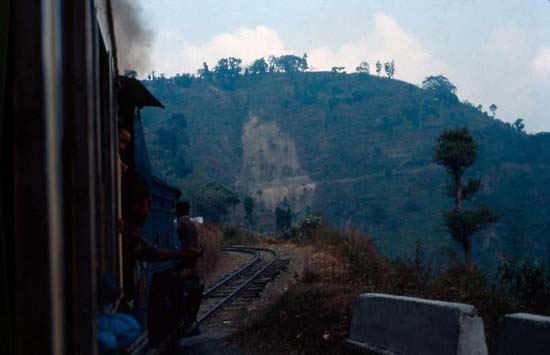
Rail to Darjeeling
The train had started the climb into the mountains shortly out of New Jalpaguri, and soon became interminable. We passed some good scenic spots but haze blocked out distant views. Deforestation marred the appearance of many hillsides.
The trip was meant to be about 8 hours, but it soon became apparent that we wouldn't arrive in Darjeeling before dark. It became cold long before then, and I had to don jeans. At close to 21.00 we rounded the top at Ghoom and descended into Darjeeling.
The whole town seemed to have shut down for the night. A Japanese girl, an Indian guy and myself felt our way around in the dark, knocked on doors for directions, and eventually found the youth hostel. I got a 10 Rs dorm bed, but the water was off and I couldn't get tea, drinks or food at all. I finally scored a litre of water and chlorinated it for drinking, and went to bed.
The water was on next morning so I managed to clean Calcutta out of myself and my raiment. The Japanese girl and I found a restaurant and some breakfast and later lunch, addressing our hunger from yesterday. The Tibetan noodle dishes and the breads stuffed with vegetables, as well as the gyathuks and momo dumplings, are good fillers.
I was only in Darjeeling about 2 full days. I wanted to stay longer and maybe do a trek up to Sandakphu and the Kanchenjunga area, but two things discouraged me: persistent cloudy skies and persistent runs. So I spent the time exploring the town and surroundings by foot.
Darjeeling is on a hillside and the streets are steep, short and crooked. It's cooler, quieter and cleaner than Calcutta, and people are pleasant and friendly. But water only runs a short time of the day, and nothing is open past about 19.00.
I explored the botanical gardens; the zoo with its collection of bears, leopards, deer and monkeys; the Mountaineering Institute Museum with its good collection of equipment, photos and information. One morning I encountered one of those travelling mini-circuses with tightrope acts etc. Another day I took a bus up to the village of Ghoom above the town. I walked through the swirling mists about 5 km to Tiger Hill, a pleasant quiet stroll through fir forests and some cleared land. The views from Tiger Hill though were completely blocked by mist.
I was up about 06.30 on the Sunday to find my way to Nepal. Miraculously the cloud had cleared and I had my only view of Kanchenjunga just before leaving. Well, I didn't trek there but at least I saw it.
I boarded a 07.30 bus for Siliguri, arriving there about 10.45. After posting some postcards, I made the mistake of going to an agent and booking a jeep/bus right through to Kathmandu. It would have been OK except the jeep I was on waited an hour or two to fill up. Then on the way to the Nepalese border, it was stopped for some time at a village because a mental case was wielding an axe or something just ahead. I didn't arrive at Raniganj at the border, and get through to Kakarvitta in Nepal until 16.10. The bus departure time from there was 16.00. Wouldn't you know it; I was 10 minutes late and the bus had uncharacteristically left dead on time.
It was 29 January; I'd been in India 18 days, but would return in a couple of weeks for a much longer stay.
Nepal
So here I was stuck in a grotty border town for 24 hours. I had to pay a cancellation fee and get another bus ticket for tomorrow. I found a room for the night, took walks through tea fields and surrounding countryside to cool my temper, had mediocre dahl-baht meals in grotty restaurants, and fought off beggars and free-loaders. I did meet up with 2 Australians who had similar troubles. Also I met a couple of Buddhist monks from near Kathmandu and had some friendly enlightening conversations with them. I would find that everywhere I went; the Tibetans and Buddhists are always good value to associate with.
The bus left, again on time, at 16.00 the day after I arrived. To add to my humiliation I was been assigned a seat near the back. This bus extended an inordinate distance behind the rear wheels, turning the rear seats into catapults with each bump in the road. This would be one of the roughest bus trips I'd ever experienced. I wouldn't get a molecule of sleep, the driver either bouncing through potholes or wildly swerving around them.
After one flat tire next morning, the bus arrived in Kathmandu about 08.30. I fought off the hotel touts, walked over to the Freak Street area and found a slightly dingy and dusty, but adequate, room in the Mustang Guest House. After breakfast and a hot shower I spent the next several hours catching up on sleep.
Kathmandu is still the place to pig out on all the western food that was unavailable in India. But the centre of gravity has shifted since the 1970's, away from Freak Street and Pie Alley to the Thamel district. Many streets are narrow and crowded, and clogged with produce and souvenir vendors. Hawkers and touts are unrelenting. Human excrement still litters the streets, even on the steps of the temples in Darbar Square.
I was 5 days in Kathmandu, sightseeing and preparing for a trek in the Langtang Valley. My diarrhoea got worse and then gradually a bit better, even when gorging myself on spaghetti, pizza, pepper steak (made from water buffalo), and cakes and pies.
The Swayambhu Temple, on a hill in the west of the city, remained a tribute to religious tolerance with its intermingling of Hindu pagodas and Buddhist stupas. The big white 16-eyed Boudhanath Temple to the north-east, the Gokarna Wildlife Reserve farther out, the still farther Sundarijal Waterfall on the edge of the valley, and the suburb of Patan to the south-east with it's own less-crowded Darbar Square, were all good destinations on a rented bicycle.
To get a trekking permit, you had to show that you've changed at least USD 70 for each week of trekking. I wasn't burning through that much money, so I changed the minimal amount of money to allow one week of trekking. Exchange rate was 14 Rs to the USD. The Langtang Valley to the north of Kathmandu looked like a good destination for that length of trek. The trekking permit cost 90 Rs, plus 52 Rs for the 9 hour bus trip to the end of the line at the village of Dunche.
So on 5 Feb I had packed up minimal gear for the trek, procured some biscuits, muesli, water and chocolate, and was out of Kathmandu on a steep tortuously winding road. Bus seats were cramped and painful, but some rewarding mountain views took my mind off the rigours.
At Dunche I found a surprisingly nice hotel with a varied menu, a contrast to the rustic accommodation I started with in the 1970's trek. Had a good sleep on a foam dorm bed.
Next day I started the trek with a Dutch girl who happened to be doing the same one. Weather started out cloudy but soon cleared. We walked for an hour along the rest of the road to the village Barkhu, then down tracks to the river and up the Langtang Khola. The track was steep in places but views of surrounding mountains, where available, were magnificent. We passed numerous small villages and crossed the river repeatedly on rickety cantilever or suspension footbridges. About 8 hours of walking got us to the Bamboo Trekkers Lodge, little more than a private home, at 16.30. A basic dahl-baht dinner with a shot of the local spirit called raxi, and some conversation with the Nepalese hostess, ended a good day. I did use up a few bandages though on various cuts and blisters.
In the morning we continued fairly steeply upwards along the Langtang Valley, through forest and alongside many rapids. At another guest house at 10.30, my Dutch companion regretfully announced that her knee was playing up and she had to stop there.
On upwards I went, stopping somewhere for a Tibetan bread lunch, and arriving at the village of Gjora Tabela at 13.30. Here the valley finally opens and flattens out, and scrub replaces trees. Villages became mostly wind-swept, deserted, stone-walled yak-herder settlements. However the cloud was closing in and I couldn't see much distant scenery. After 2 hours more gradual climbing, as I reached Langtang Village, I could feel the 3500 metre altitude, with typical symptoms of cold, fatigue, slight headache and frequent urination.
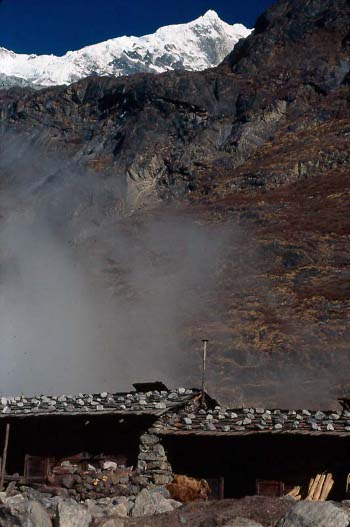
Langtang Villaqe
But Langtang was a pleasant village of stone huts with wood roofs, stupas and prayer wheels and a few guest houses. I checked into a bed at Lovely Langtang Lodge. A friendly and personable Tibetan family were the hosts for myself and a smattering of other trekkers. This would be my base camp for a couple of days. After a good dahl-baht (lentils and rice) dinner I talked with others about walks farther onwards, and had a beautiful nights sleep.
On the third day of the trek the weather was again totally clouded in with sleet on the ground, but it mercifully cleared at breakfast.
Today's agenda was to don day-gear and walk farther up to the small monastery settlement of Kyangin Gompa, an easy 2 hours or so. KG is a bleak stone-hut village in an open grassed area, dominated by a huge rock stupa and its ancillary multicoloured prayer flags. Another walk of an hour or so up the slope to the north of the valley, and I was at 4100 m altitude, just below the huge and slightly intimidating Lirung Glacier. I would have gone up to the glacier itself, but it was making funny noises and bits were falling off it, so I prudently kept my distance.
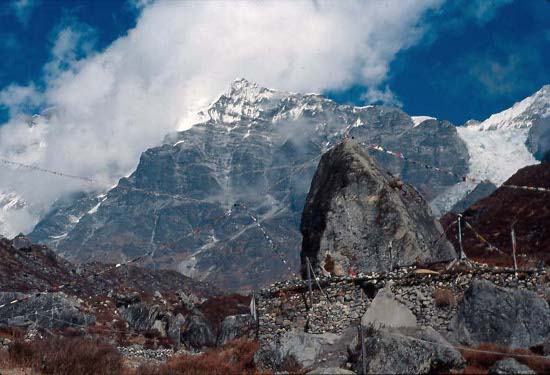
Lirung from Kyangin Gompa
It did hang around the area for an hour or two though, wandering around and taking in the scenery. It was incredibly isolated and beautiful up here. I soaked in the short heather-like vegetation, partly-frozen creeks, fan-shaped alluvia, swirling clouds and jagged snow-covered peaks. I didn't want to leave. Time pressed on me though and I reluctantly started back down close to 14.00. It was well I hadn't tarried longer; cold, wind and sleet returned.
Back at Langtang at 16.30, a few more trekkers were in the lodge, including my Dutch companion who had finally overcome her knee problem and caught up. We toasted with chang (an insipid milky rice-wine drink) and feasted on more dahl-baht and tea.
Days four and 5 of the trek were a return down to Bamboo Lodge for the first night and thence back to Dunche. It wasn't much easier going down than it was going up, and my feet were a bit sore at Bamboo. I had a cold shower there and washed a few clothes, then had difficulty warming up.
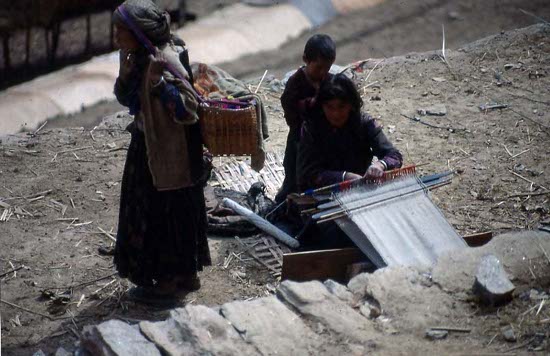
Women, Syabru
The final day I saw and heard quite a number of monkeys in the bush near the exposed village of Syabru, and got good views of the Ganesh Himal mountains from the village itself. I covered the final few km back to Dunche in the company of an Aussie trekker, John, and his Nepalese guide. Later in the hotel I talked and dined with John while the guide went out drinking with his friends. At night in our dorm the guide was so drunk he was pissing on the floor between our beds, a bit disconcerting.
It rained heavily overnight and next day we saw heavy snow cover on surrounding mountains; glad we weren't still up there. A slow, crowded, winding bus trip, vomit (other peoples') on the floor, had me back in Kathmandu late in the day. I checked back in to the Mustang GH and treated myself to a steak, chili-con-carne, tea and apple crumble for dinner.
For most of the time on the trek my diarrhoea disappeared, but it returned in Kathmandu. It seems always that the cities are less sanitary than the country. That's the cost of the varied menu.
The next 3 days, my last in Nepal, were taken up with mainly administrative chores, getting a small visa extension, developing some slide film, receiving mail and doing postcards, organising a bus back to India, fighting diarrhoea and resting. Rain and mud marred some of the activities.
My bus left Kathmandu on 14 Feb at 20.00. A slow miserable trip along wet, truck-congested roads got me to the grubby border town of Birganj about 07.00 next day.
Return to India
I had a headache and wasn't feeling at all well. As the bus stopped, a horse-cart driver poked his head in looking for westerners and spotted me. In my condition I relented and accepted his ride across the border. But his price of 35 Nepalese rupees changed to 35 Indian rupees in Raxaul on the Indian side. There seemed to be one rip-off after another, a young guy trying to charge me for putting my pack on the bus, and then I paid double the going rate for the bus to Patna. All this spoiled my mood as well as compounding my physical ailments.
Anyway, I had changed some money for Indian currency and was on the bus by 08.15. This ride was better than last night, getting me to Patna by 14.45. I was starting to feel better now.
Patna is in the heart of a relatively impoverished part of India, definitely not a touristy area, and not many people speak English. There was not a lot to see here, so I proceeded straight to the train station to try to get a ticket through to Puri on the Orissa coast. But there were no direct trains there, so I had to settle for a sleeper for Calcutta for 18.30 tonight.
I killed time with a couple of meals of masala dosa and peas and chapati, hanging around chai stalls drinking tea, and trying to rest. I found a barber and considered a haircut, but couldn't communicate with the staff so gave up.
The train was late by a number of hours, and I eventually got on a train, but it was the wrong one. Had to change at another station farther on, finally getting my berth on my train about 10 pm. The train had more delays on the way, sitting in stations a lot and being used as a marketplace for hawkers.
Finally in Howrah Station, Calcutta, at 10.30, my first priority was to book onward transport to Puri. They were booked for the next couple of days, "Try the foreigners office in BBD Bagh". Over there I finally did get a ticket for a couple of days later, for 22.15 on 18 Feb.
So I had a couple of days to kill in Calcutta again. I caught up on laundry, stuffed myself on, and started to get a bit sick of, vegetarian food. A re-visit to the Prem Dan refuge renewed old acquaintances including my Dutch friend Twan. One afternoon I took the metro to the south of the city to meet Twan in his new accommodation. But I couldn't find him and had to return down-town after getting ripped off by rickshaw drivers. Another afternoon I looked through the dusty decaying exhibits of the Indian Museum. I got a short haircut on Sudder St, so I would be OK for a while.
On the evening I was to leave, it rained heavily. Taxis were in short supply so walked to the station, getting my feet wet and dirty in the process. It was a long wait in the station drinking tea and fending off beggars. I finally got on the train and going at 01.30, 3 hours late. One thing that impressed me was the posting of the passenger lists on the side of the carriages, so I could find my place quite efficiently.
The train came to Bhubaneshwar quickly, but then was slow the final 60 km or so to Puri, arriving about 10.30. A short rickshaw ride got me into a basic but adequate room in a guest house in the fishing village.
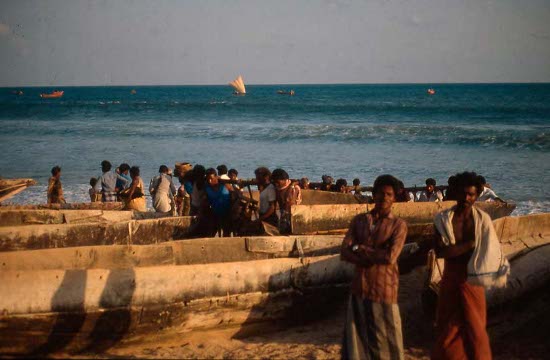
Boats, Puri
Puri is a mixed bag. It's a pleasant enough beach town popular with travellers. The main activity besides tourism seems to be fishing, a wonderfully picturesque activity that can be observed from the guest house or from the beach. The fishing boats are among the most primitive I've seen. They are made of shaped logs tied together like a raft and powered by sail. Heavy and unwieldy, they usually seem to capsize when coming into shore. Accommodation is reasonable and the food is great, especially the fish. Weather is not too hot yet at this time of year, and bicycles can be rented for trips around the town and countryside.
However, the beach is full of excrement and dead turtles, and disgustingly smelly in places. Kids seem to know only 3 english words, "Hello", "chocolate" and "paise". One sleazy-looking guy would come around quite frequently trying to sell us rubies and diamonds. It turned out to be hard to get enough small change for day-to-day living.
I was in Puri about 6 days, a reasonable time as I liked the place and didn't get sick at all while here. I hired a bicycle a number of times to ride along the coast, looking at sand dunes, scrub and unfinished windmills, to go into the main part of town to see temples etc., or to ride inland exploring casuarina forests and small villages. Mornings would usually be spent on a bike, and the hotter afternoons on the beach. There was a good number of other travellers to dine and share activities with, including people I'd met in Calcutta and some Japanese travellers that I spent time with. In the evenings I found I had a 1 hour window in which my Walkman could pull in Radio Deutsche-Welle from Sri-Lanka and feed my news-starved mind.
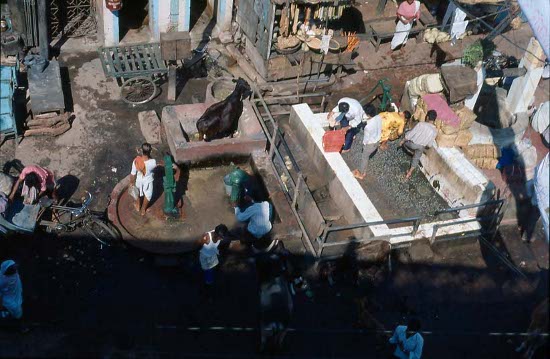
Street, Puri
A few of us had a look at the Sri Jagganath temple in Puri. This is origin of the word “Juggernautâ€, as once per year a monstrously heavy stone vehicle is trundled out and along the streets. The temple is closed to non-Hindus, so we had to content ourselves with viewing the temple from the roof of the library across the street.
One afternoon and evening I met up with several other travellers and booked a tourist bus to the nearby coastal village of Konarak. Here is the home of the World Heritage listed 13th century Sun Temple. It was built as a huge stone chariot with 12 stone "wheels" and intricate relief carvings from the Kama Sutra. The sunset coloured it in a fascinating way.
After a light dinner of samosas, biscuits and tea, in the evening we took in the Konarak Dance Festival. Several North Indian dances were followed by a ballet with the themes of Krisna and Rukmini. It was wonderful, 3 hours of exquisite music, singing, dancing and costumes; certainly better than sitting on the beach or at home.
On Feb 26 at 22.40 two or three of us were on the Coromandel Express from Bhubaneshwar to Madras. Waiting a couple of hours at Bhubaneshwar, I treated myself to an ice-cream and got the runs later from it; will I never learn?
As we travelled south it inevitably got hotter. We arrived in Madras at 18.15, nearly a full day on the train. We walked a fair distance along crowded noisy sweaty streets before finding beds at the Malaysian Lodge. By mistake I paid twice for my bed, but Indian hotels never refund on overpayments.
Food etc seems to be more expensive here than expected, e.g. 2Rs for a chai instead of 1Rs, and 10 Rs for a litre of water. Maybe it's just because it's a big city. In any case I was not impressed with the ambiance of Madras, and resolved to move on as soon as possible.
I wandered around next day trying to find a train station that would sell me a ticket onward. Finally I got a ticket for 19.00 tonight to Madurai, and another ticket from there to Quilon on the Malabar coast for 7 March. That would give me about a week around the Madurai area.
Later that afternoon a couple of us took a bus to Fort St George, one of the few sights in this city. We found little of interest either in the fort or the museum contained within.
At 18.15 I was on the train with other travellers bound for Madurai. We took advantage of friendly Indian from Bombay in the same compartment, pumping him for conversation and information about India. At 06.15 next morning I was at Madurai train station.
My aim was to continue straight up to the hill station Kodaikanal, and see Madurai on the way back. I allowed myself to be steered to a bus agent, and he blessed me with the privilege of purchasing the ticket to Kodaikanal for 25 Rs including a rickshaw ride to the bus station. I later found that the real bus price was 13 Rs, and that I could easily have walked to the bus myself. Just more hassle and humiliation, all part of the India experience. Later, getting to the bus, they tried to charge me again for the rickshaw. I had an altercation with them and refused. On the bus with me was an Indian family from Bombay, also on the way to the hill station. The woman observed my dispute, and kindly assured me that it's not just me; they also get fleeced by these people. That made me feel a whole lot better.
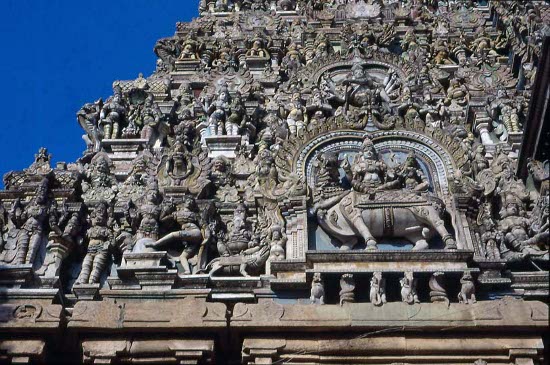
Shree Meenakshi Temple, Madurai
Earlier, I had a couple of hours to spare before boarding the bus, and wandered over to Madurai's main attraction, the immense and intricately ornate Shree Meenakshi Temple. With its four gateways comprising thousands of brightly painted effigies, it must be south India's most impressive temple. Inside, in the cavernous corridors, I watched a man leading an elephant down the hallway, totally in-proportion.
Our bus left at 09.15, made good time through flat country, rice fields and villages. I quickly made friends with the Bombay family that had given me moral support in Madurai. They were really wonderful people, and I would later run into them once or twice in the hill station and spend time together.
At one village stop, the bus started up again with two of the foreign passengers missing, maybe still in the toilet. Only some shouting and protests from me and other passengers made the driver stop and pick them up.
Up into the higher country, we passed through bare hills and pine and eucalypt forest, and entered the cool and pleasant hill station of Kodaikanal. Aspects of the area were reminiscent of Darjeeling and Cameron Highlands (Malaysia), and, from the eucalypts, Australia. This place would grow on me as a favourite in India.
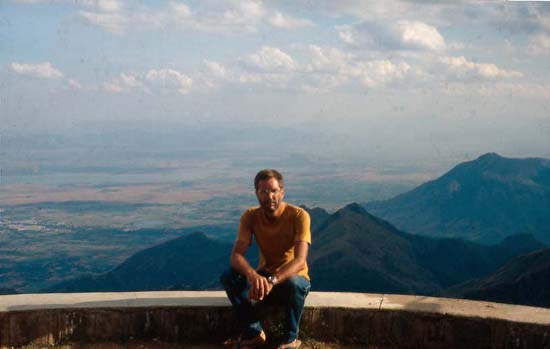
Kodaikanal
A group of us wandered around trying to find a place to stay, eventually coming across the Greenlands Youth Hostel. It was perfect; cheap, comfortable, friendly, great views and good big cups of tea. I would savour sitting out on the balcony gazing over the plains below, imagining the heat, noise and clamour down there as compared to the cool, peace and tranquillity up here. This is heaven. I slept wonderfully up here.
The town is centred on a small lake ringed by a pleasant walking path. Horse riding is popular here, patronised by Indians who obviously had never been on a horse in their lives. It's almost comical to watch a young Indian on a horse trotting or galloping around the lake, his handler running as fast as he can in front holding the reins. John Wayne would not be impressed.
Food was good too. Lunchtime would normally find me in a small restaurant by the lake enjoying paratha (very similar to those wonderful Malaysian roti canais), dahl, omelettes and chai. Dinners comprised pizzas, lasagna, chicken sizzlers, soups, pies, even a beef steak once, apple crumbles and other western or Indian dishes. I could get brown bread, peanut butter and honey to snack on.
I spent about 4 full days up here. There are a number of walks around town and surrounding countryside that can be done at a relaxed pleasant pace, although not always without crowds of people around. Gum tree forests, pine trees, orchards, swamps, lawns and gardens all reminded me of other, non-Indian, places. One path or road led me to what looked like an old convent or school. The two gate posts had the words "Stadacona" and "Hochelaga" inscribed on them, the pre-Canada names for Quebec City and Montreal; what are they doing way out here?
Pillar Rocks are about 7 km away, full of noisy tourists and too much cloud for a good view that day, but it was possible to find some solitude to write postcards. In another direction was a waterfall called Bear Shola Falls, another good place to get away from the town crowds.
Much as I hated to leave, I eventually had to get a bus back down to Madurai in order to make my train connection to Quilon.
At one point we passed a funeral parade, the deceased tied in a sitting position on a high sedan chair, glasses covering her eyes, quite a joyous-sounding affair propelled along by much noise and fanfare.
Back in the heat and clamour of the city, I found a room and later wandered around the streets observing spontaneous dancing and everyday life. In the evening at the Shree Meenakshi Temple, there is a nightly ritual of "putting Shiva to bed". The priests and followers put the effigy of Shiva from his temple into a sedan chair, and with much horn music, chanting and waving of fans, carry Him to Parvati's temple for the night. Quite a spectacle.
After a fitful night's sleep from the heat, I was up at 05.40 for the 06.50 train to Quilon. The trip through rice paddies, banana trees and dried hills, took just over 7 hours but felt longer from the hard seats.
At Quilon, I transferred directly onto another train going south, and arrived in the town of Varkala about 15.00. From there a bus took me to the nearby beach village on the Malabar coast. Varkala Beach was just being discovered at the time, and was not yet in the guide books. But it had that laid-back, idyllic character that travellers crave, a place where they arrive and don't want to leave. The main village is back somewhat from the cliff-ringed beach, and just at the top of the cliff is a little "fishing village" with basic home-style accommodation. I found a slightly uncomfortable room in the village for a couple of nights. Later I moved into a simple but perfectly adequate room in a private home in the fishing village, where a woman called "Grandmother" did the meals. Along the beach at the bottom of the cliff, a couple of springs discharged good safe drinkable water, the first place in India where I could get good water for free. I drank myself silly.
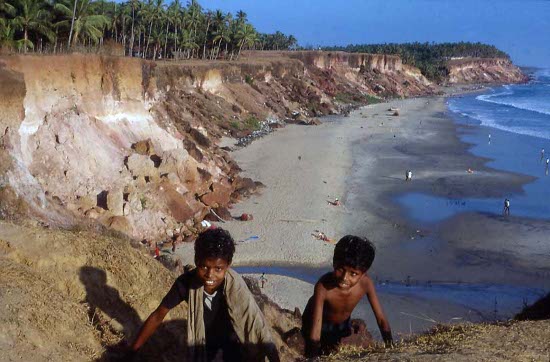
Varkala Beach
I spent 5 full days here, and loved every minute of it. I walked a lot up and down the coastal cliff-tops and beaches, talking to locals, helping pull fish nets out of the ocean, and drinking coconuts that were offered gratis. Of course a lot of time was spent swimming and relaxing on the beach, especially as it was frequently too hot to walk far. A group of us travellers hung out together, walking, taking meals, beach (in)activities, and partying outside our rooms into the morning hours. We dined on curries, vegetables, fish, chips, biryani, rice, bananas, chapati and parathas.
One evening a group of us walked into the main town to take in the open-air theatre. A big crowd attended an Indian sit-com-type play on a stage, noisy speakers and music. I couldn't understand a word of the dialogue, but it reminded us of the Honeymooners or Lucy Show.
At 09.00 on March 13, I was on buses to Varkala railway station and to Quilon by about 11.30 I found a room and started to check out the backwater boat trip to Allepey. I was told that the normal boat is being repaired, so the only service available is tourist boats (Why do I feel that the boat will never be repaired?). The rest of the day I explored the streets and markets of Quilon, pleasant and full of atmosphere. The evening was especially attractive with its dim lighting, heat-induced lethargy and exotic sights and smells. I'll miss it all when I'm back in "civilisation".
Next day I decided to take the tourist boat (50 Rs) for the backwater trip. A ticket was 50 Rs and it started at 10.30 for a 9 hour trip. The boat was full of ferangs, the locals probably can't afford it. I was able to sit on top of the boat.
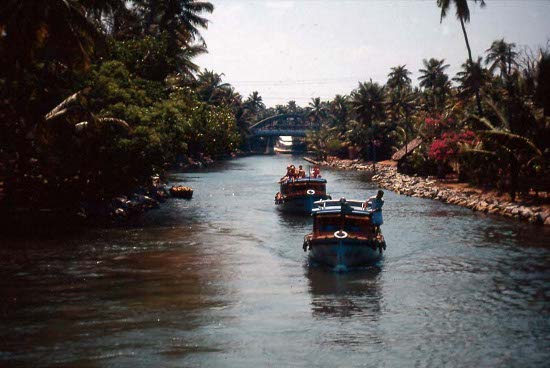
Backwater, Kerala
All-in-all, it was a pleasant and memorable trip. we navigated narrow canals and waterways and across lakes, stopping at locks once or twice to change water levels. Lakes were dotted with Chinese-style dip nets, dugout canoes and boats loaded with whatever cargo to within an inch of sinking. Villagers waved from the banks and kids yelled for pens. Vast coconut plantations ran to the horizon.
I decided not to stay at Allepey, catching a bus straight to Ernakulum and arriving about 21.15. A considerable search, and I found a very nice hotel room for the very reasonable price of 26 Rs. Then out to a good restaurant for a dinner of Chinese food to celebrate my birthday and having made it this far in my travels.
Ernakulum is the city here, but nearby Fort Cochin on the coast is the place to go. So next morning I found the ferry and took it across the waterway. At Cochin I found a basic room for the next 3 days.
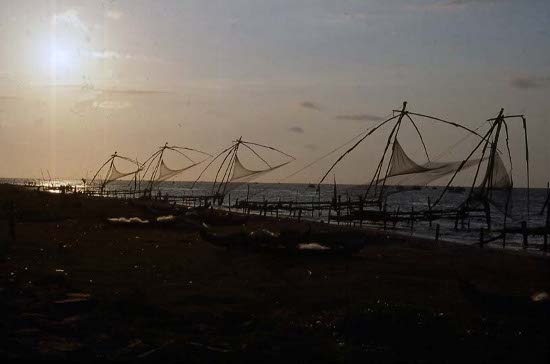
Fish Nets, Cochin
Cochin was a Portugese colony, and contains a lot of history. I walked around a lot exploring Willington Island, Mattancherry and Cochin itself. The Dutch Palace Museum exhibited sedan chairs, portraits of rulers and extensive Mahabaratha murals. The Jewtown Synagogue was closed when I was there, but the proximal area was richly pungent with spice warehouses and curio shops. The park near the foreshore fish nets was a good place to watch sunsets. The beach farther around had too many men looking for same-sex. Also near the shore is the Church of St Francis, linked to Vasco de Gama and notable for its many Portugese and Dutch tombstones.
One worthwhile activity was a ferry into Ernakulam in the evening to attend an exhibition of Kathikali dance. The performance was small-time, and pretty much a tourist thing, but good to see anyway. 2 dancers, 3 musicians and 1 commentator took us through the 1 hour performance, with elaborate costumes, heavy make-up and complex dance routines. How can they do anything in that heat?
The evening of St Patrick's Day found me in the Ernukalum bus station, chafing with sweat and waiting for an 20.00 bus to Mysore. I was so hot and sticky, and had been for .as many days as I could remember, that I wondered if I could ever be cool and dry again. The vinyl bus seats didn't help. But as the bus travelled up into the hills, I finally did cool and dry off; what a fabulous feeling!
Despite not being particularly high in elevation or latitude, Mysore is definitely cooler and more pleasant than the plains or coast. I could walk around in comfort without sweat or heat exhaustion.
I found a nice but slightly expensive room, having noticed a dearth of good accommodation at lower price ranges. Breakfast, laundry, rest, and train reservation for Goa a couple of days hence took up most of the morning.
In the afternoon I saw the Jagan Mohan Art Gallery; some good paintings by Indian artists, but dominated by ostentatious works by various Maharajas. Next was Mysore's main attraction, the Maharaja's Palace, or Mysor Palace, an even greater level of kitsch grandeur.
Later in the day I walked to and ascended the steps up Chamundi Hill. It was just getting dark and I barely got a picture of the giant Nandi bull statue part way up, before continuing in near darkness to the large but not very distinctive Hindu temple at the top. It's a good place to view the city and surrounding countryside.
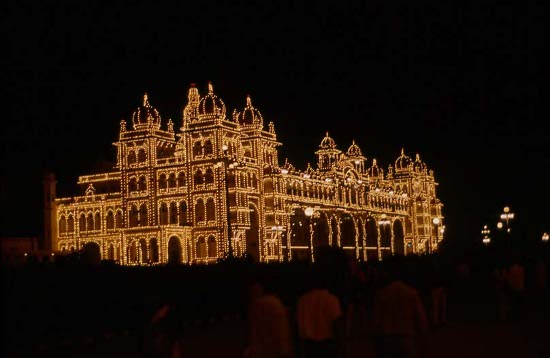
Maharaja Palace, Mysore
Back in the city, my return took me past the palace again, now lit up with thousands of light bulbs like some Las Vegas prop.
A good dinner was made up of fish masala, roti, salad and a chocolate sundae.
Next day I caught a crowded local bus through dry and stony country to the small city of Hassan, to find and visit a "friends of friends" family. Found a hotel near the bus station for a room and a thalee lunch. After considerable searching and asking in the afternoon, I found Shama Rao's house, and agreed to be picked up later at 21.00 when he gets home. Later in the afternoon I explored the outskirts of town, found the train station and enjoyed the picturesque countryside at sunset.
The family met me about 21.00 and took me home for a couple of hours. They are a really courteous and hospitable family, such a contrast to the touts and scam artists you met in tourist areas. They tried to feed me another meal, but I was too full to eat much.
Next day Shama Rao took the day off from his job to show me around a couple of temples about 20-30 km away. He brought a good lunch for us of chapatis, coconut/vegetable/chili dip and bananas.
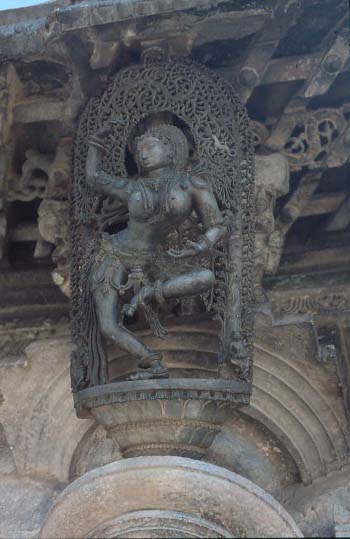
Detail, Belur Temple
First stop was Belur and its intricately carved and well preserved Visnu/Krisna/Ganesh temple. The stone used was good quality and displayed many scenes and motifs in great detail. Inside was a large number of columns, each sculpted in a different design.
In the afternoon we saw the Shiva-based Halebid temple, but with some Jain motifs and characteristics. It also was intricately worked, but not as well preserved as Belur.
In the evening, back in Hassan, my family took me to the train station for the 21.00 train for Goa. Their hospitality was impeccable and it was sad to leave them.
This must have been a branch line, as the train was steam powered, slightly unusual even at this era. It took me to Ariskere about 21.30 where I changed to diesel for Goa. In the station I watched a noisy altercation between stall holders and station staff or someone. Much shouting, gesturing, threats and posturing, but no physical fights or anything; it drove home that for all their hard life, they are not, at least at this level., a violent people.
I met a couple of other travellers on the train, who were going to Beneaulim Beach in the south of Goa, so I decided to go there too. We arrived in the town Margao about 13.00, and caught a crowded local bus for the few km to Beneaulim. I found a room in a local house to stay in, slightly smelly from mildewed grain, but otherwise fine. I get the feeling that as ferangs walk past, the locals quickly vacate one of their rooms to rent to us. At least the price is right in these places, about a dollar a night. I found the toilet interesting, a simple outhouse in the back, with the usual hole in the floor. As I walk toward it, the pig falls into line behind me. As I enter, the pig goes around back, and I can look down the hole I see its face looking up, patiently waiting for its meal.
The beach is about 200 m from the room, a long wide stretch of reasonably clean sand with a few bamboo/thatch restaurants and bars.
The couple of days I spent in Beneaulim were mainly on the beach, sometimes with my friends, swimming, writing postcards, eating in the beach restaurants, and watching the big turboprop Tupolev "Bear" bombers doing slow lazy manoeuvres over the ocean. Strangely for India, we didn't get hassled much by hawkers or touts.
One evening I signed up for a buffet meal of fish, calimari, ocra, eggplant, rice, noodles, chapati and salad and beer; a huge and good feed. One afternoon I rented a bike and rode into Margao to mail postcards, then north to explore the more-developed Colva Beach, and finally back home. I found that it's warm in Goa, but not so hot that I couldn't ride a bike or suffer much from heat.
I decided to leave Beneaulim and try Chapora Beach in the north of Goa. It took all day to get up there. First was a bus to Margao. Then I wanted to book my train for a few days hence to Bombay, but had to wait until after 15.00 to get the ticket. )nly then could I find the bus terminal outside Margao, get a bus to Panjin, find the ferry across the river, get the bus to Mapusa, and another to Chapora. I arrived at 18.45, wondering if it was worth the move. But I did find a good room in a local house and a good big meal in a nearby restaurant.
Chapora is more built up than Beneaulim Beach, lots of restaurants, coloured lights and music. The beach water is less clear here, maybe because it's on a river mouth. But there are more places to walk around to and sights to see, including the huge Chapora Fort on the headland. All-in-all, there's not a lot to choose from between these beaches. I did take a walk south to the somewhat better known, and more of a celebrity destination, Anjuna Beach one day, but didn't find much there to recommend it. Chapora is fine.
The beaches had lots of hawkers and beggars. Apparently begging here is quite an industry, run by a couple of families or gangs, with police paid off and competition discouraged. I heard rightly or wrongly that a beggar here could make maybe 80-100 Rs per day here, a phenomenal amount by local wage standards. "Ear cleaners" roamed the beaches, coming up to me, inserting a wire in my ear, placing by sleight-of hand some wax on the wire, and trying to convince me that the wax was mine and my ears need cleaning. Another scam was the "dumb" beggar kid who holds his tongue back in his mouth to look like it's been amputated. More common were the kids that showed fake references or letters from some charity to get a donation.
The drug scene here is not as predominant as I expected, primarily I believe owing to police and tourist bureau action. But there were a few chillums being passed around in restaurants. There was said to be a big drug party one night somewhere outside of Goa, but not my scene.
On 27 March I was on the way out of Goa, bound for Bombay. An early start got me to Panjin in central Goa at 07.30 where I would catch the 12.30 train out. That gave me time to take a bus the 9 km out to Old Goa to look at historical churches. The churches were large but nothing special to look at, and anyway I had to rush to get back to the train on time.
With a change of trains at Miraj, I was in Bombay at 08.00 next day. Three British girls and I shared a taxi to the Salvation Army Hostel, where we checked into dorm beds. Bombay is big of course, modern and clean in parts, and grotty and slummy in others.
Travellers' stress seems to be an issue here. Maybe it's because most travellers who end up here have been in the country for some time, and it's getting to them. I observed a couple of serious altercations between ferangs and locals, born of frustration or perceived incompetence. Maybe it's because many locals don't apologise for mistakes or acknowledge differing opinions. One relatively mild dispute was with our taxi driver on arrival, because the meter seemed to rise astronomically and the fare was much higher than expected. In the Sally, a westerner got into a fistfight (rarely seen in this country) with a hotel manager over some inaccurate directions or whatever. Another time, a new arrival was being allocated a bed in my dorm. The manager indicated a top bunk, unaware that there was another guy sleeping on it. The new arrival threw his pack up onto the bunk, landing on the incumbent, who immediately exploded in a rage at the manager for not checking if the bunk was free. It only settled down after near violence and repeated threats to "call the police" etc.
At this stage of my trip, I too had been in India for a long time, nearly 3 months, and my visa was about to expire. So one of my first priorities was to find the visa office and apply for an extension. I found the office about noon, but with queues and hassles getting photocopies made, I didn't get the application done until about 15.00, to pick up the visa in 48 hours.
At the tourist office I was able to plan the next part of the trip. After picking up my visa, I would go for 3 days up to the hill station Matheran 170 km from Bombay. On return to Bombay I'd finally try for a place off the beaten track, Bhuj in western Gujarat. I booked a train ticket to Gandhiham in Gujarat for 17.15 on 3 April.
I had about 3 days in Bombay. Of course I had a look at the nearby India Gate, pretty much as per the photographs. I took a walk to the southern part of the city and back to a high-rise district where I found the Australian Consulate, finding out there that I'd missed the federal election and that Labor had won. A long trek from the hostel took me along Marine Drive to Chowpatty Beach. One morning was in the Prince of Wales Museum, studying the routine array of Hindu statuary, ivory carvings, arrowheads, religious paintings, and a good section of classical European art.
I was starting to not feel all that well here. Diarrhoea was returning off and on, I felt dehydrated despite large water intake, low appetite and low energy levels.
On 31 March I was up early to catch a train to Matheran. A 09.00 train from Victoria Terminal got me to Neral. At 11.00 I was on a narrow gauge train similar to the Darjeeling one but diesel, up through dry hills, arriving in Matheran at 13.30.
Matheran is only about 800 m high, but is a hill station nonetheless. It's just high enough to be not hot, though less cool than Kodaikanal or Darjeeling. Interestingly, it cost 7 Rs just to enter the town, must be a park fee or something. It's a hilly plateau, small enough to walk to the edges and lookouts in any direction. Dry and dusty, but enough trees for shade. I explored the little mud-sided dam called Lake Charlotte, and all the lookouts to the south and north of the plateau. The country below looks like arid sunburnt badlands.
Several local workers were pushing cartloads of bricks, mortar etc. up the road to the town. Interestingly, one group of young guys was stopped on the road, out of sight of the boss, trying to lighten their cart load by surreptitiously slitting open some of the cement bags and letting the material run on the ground. Like labourers everywhere.
On the day of my train to Gujarat, I took the return train trip down to Nagar and to Dadar, north of Bombay, where I could connect to my Gandhidham train. One of the trains was very crowded and I had to get off and wait for the next one so I could sit down. I was still feeling dehydrated, weak, slightly sore, jaundiced and poor appetite. I was coming down with Hepatitis A, but didn't yet know it because I didn't feel sick enough.
I waited at Dadar for a while for my train, then found it doesn't stop there, and went on to another station where my train does stop. On the train at 17.15, I didn't have berth allocation; it took some time and hassles to sort that out. When I finally got a berth, some local youths didn't want to vacate it for me. I had to insist on it because in my condition I really needed to lie down, and finally was settled at 21.30.
In Gandhidham, Gujarat at 07.50, I splurged 2 Rs for a rickshaw to the bus station. An 08.40 bus (9 Rs) got me the rest of the way through flat scrub country to the main Kutch town of Bhuj. Even before the town, I could tell we were getting somewhere because of old fortress walls along the nearby hilltops.
Bhuj is a neat little place, the "capital" of the Kutch distrit, and one of the more remote parts of India. Not many travellers come here so I felt a bit adventurous.
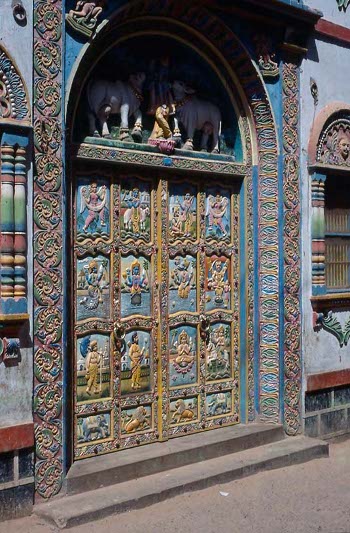
Temple door, Bhuj
The main feature of Kutch are those vast and weird dry/wet swamplands called the Great Rann and Little Rann, running all the way up to the Pakistan border. I didn't feel up to going out to the edge of the Great Rann, only seeing part of the Little Rann on the train coming and going. But Bhuj was still a marvellous place to visit. The old town is walled, and makes for a fascinating wander. I walked around the west and north of the town and viewed the acacia-studded plains and dry hills from the top of the wall. But the Rann was too distant to see from here. Back in the centre were interesting Hindu temples with ornate doors and friendly locals who could talk about history of the place without asking for baksheesh. The Palace Museum was a routine but interesting junk shop of faded glory.
I was too tired to sightsee for more than half a day at a time, resting the rest of each day. The food here seemed somewhat too greasy for my taste, so didn't eat a lot. I missed western food and would lie in my bed at night dreaming of Big Macs and lemon pie. At the museum I met one of the few other western travellers here, asked him if he thought I had hepatitis, he looked at me, and said yes probably. I must get it checked out sometime.
After only a couple of days in Bhuj, I took the 13.30 train on 5 April for Ahmedabad. I had no sleeper reservation, in fact there was no ticket collector on the train. It was a pretty horrid trip; slow, crowded, noisy, hard seats, hot and poor food. I bought a packet of glucose biscuits to munch on, like eating cement. I was able to stretch out on a top shelf so slept a bit.
I was in Ahmedabad before 06.00, and decided on going straight through at 06.40 for Udaipur. Bought some water and spicy bread for breakfast. Later I tried to keep alive on bananas, oranges and spiced tomatoes. My shorts are almost falling off.
The train chugged through desert hill country and bleak little railway stations. We were getting into Rajasthan, evidenced by passengers with turbans and colourful costumes. At one point the locomotive, a 4-6-2 steam, couldn't make it up a hill, only succeeding after several tries and by the crew spreading sand along the rails.
I was in Udaipur on time though at 18.00. A rickshaw took me to the Mewar Inn where I could get a room and a real meal of vegetable soup, fried rice and cocoa. After cleaning up I looked at myself in the mirror, saw jaundice, and resolved to get it checked some time. Slept about 12 hours that night.
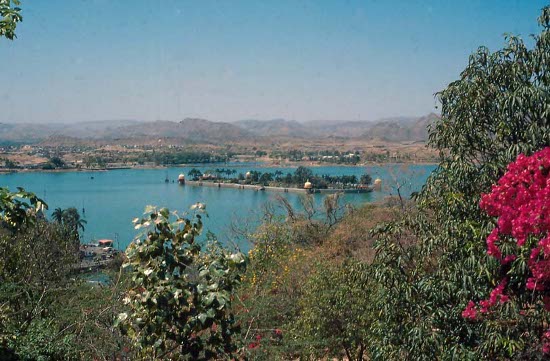
Lake, Udaipur
Udaipur is "the Lake City" and a "romantic city in a romantic state". The essence is of Maharanic history and splendour. Pichola Lake is beautiful, probably just because any lake in the Raj desert has to be so. From the shore can be seen the Lake Palace Hotel covering an entire island, an over-the-top oasis of opulence well out of my budget. Arid, fort-capped hills surround the lake.
The City Palace, started by Maharana Udai Singh (see where the city got its name?), towering over the lakeshore, is the largest in Rajasthan. The casbah maze around the palace makes it difficult to find the entrance. The museum in the palace consists of rooms and passages built by successive Maharanas and exhibits some really over-the-top paintings. One painting I particularly remember was a horse-mounted battle scene in which the hero slays an opponent. With one downward swipe of his sword, he cleaves the enemy's torso lengthwise and cuts the horse in half. Not even in the movies....
Near the lake and Nehru Island is the hilly Pratap Memorial Park named after a local hero who fought the Moghuls or something. One hill was dominated by a large statue of Pratap on his horse. The stallion's testicles were almost human-like and much more prominent than those on a real horse; testament to macho artistic licence.
One evening at 18.00 I went to Bhartiga Lok Kala for a 1-hour puppet show, delightful in a refined Howdy-Doody style. Intricate movements portrayed a forest legend, Moghul scene, and a performing circus. Following the puppet show were traditional folk dances by Rajasthani performers.
I was staring to feel a bit better and eating a bit more. So on the second or third day in Udaipur I thought I really should see a doctor, just to verify that I'd really had Hepatitis. At the very rough and basic hospital in the afternoon, I got in to see a doctor, and he asked me to come in next day for tests. He also gave me a script for medications and said "absolute rest". Yeah right!
After the doctor, I went back to the Bhartiga Lok Kala to see the museum there, a good exhibition of Rajasthani tribal costumes, culture, dance, puppets and religion. Then back to my room for some of that absolute rest I was ordered to take.
Next day I was back in the hospital at 08.00 for tests. After a lot of stuffing around and buck passing, it was finally organised. I went across to a local pharmacy stall, bought a new syringe, and had the blood sample taken. Results should be ready this afternoon. After breakfast of bread and peanut butter and fruit, and lunch of masala dosas, I relaxed in the nearby peaceful fountain park. Back at the hospital later, it was now closed, so I'd have to get my results next day.
Down-town at dinner in the Four Seasons Restaurant, I met and talked to another couple of travellers. It seems Pushkar might be the next good place to go to. Also interestingly, there was now rioting in Ahmedabad where I'd passed through 5 days ago. Also, I'd heard on the radio that there was still trouble in Jammu and Kashmir, maybe can't go there this trip, and riots/curfews in Nepal where I'd been months ago.
Next morning at the hospital I finally got my results, yes Hep A; more medicines - mainly B-vitamins - and instructions to eat sweet food and fruits and not fried food. OK, so back home for brunch of porridge, tea, bread, peanut butter, jam, oranges and bananas, and more rest.
On 12 April I rested most of the day, stocked up on transportable food, paid the hotel bill, took a rickshaw to the train station, and got a ticket for the 19.00 to Ajmer. I couldn't get a berth at the time, but was able to find an upper plank in the carriage to lay on. The train stopped in Chittor at 23.00, and I had to wait until 02.45 for another train to Ajmer. Fortunately, my carriage was waiting there in the station, so I could board it early and stretch out on the floor for some sleep.
In the large bustling city Ajmer at 08.30, I made my way on foot from the train to the bus station, where I caught a bus for the short run over the mountains to Pushkar.
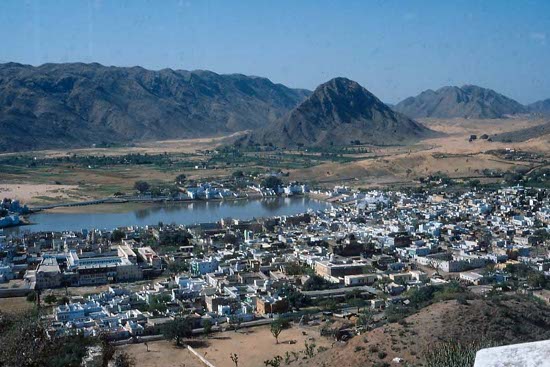
Pushkar
Pushkar is a pretty little temple-studded town just to the west of Ajmer in the Rajasthan desert. It's a popular freak centre where travellers rest up after the rigours of their journey. The town is built around the compact and holy Pushkar Lake and, being the site of the formation of the universe, it contains one of the few Brahma (the creator) temples in India. Hot as blazes, but very relaxing and an ideal place to spend a few days or even weeks to recover and recharge. The main drag is lined with souvenir stalls and restaurants. Accommodation and the strictly vegetarian (not even eggs) food is cheaper than in Udaipur.
After finding a nice large fan room in the Krishna Guest House, cleaning up, having some bread and peanut butter and bananas for breakfast, resting for 3 or 4 hours, I did feel that I was recovering from my hepatitis. I spent the afternoon having a thalee lunch, exploring the town and out to the desert studded with rocky ridge hills and small dunes.
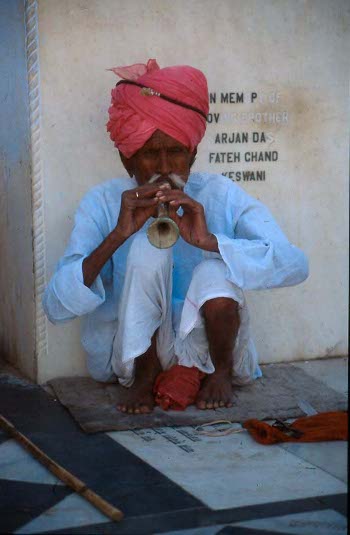
Sadu, Pushkar
In town, I had an altercation with a young local hustler who, pretending to be a holy man, invited me to perform a puja ritual in the lake, for a donation of course. Having just had hep, and still nursing the runs, I was in no humour to immerse any part of my body in the lake, and he became very upset and abusive with me for "insulting the religion". I might have been concerned if I thought he was a real priest.
I met up with Christophe, a Swiss guy I'd met in Udaipur. We would spend some time together and, as fate would have it, we never since have lost contact with each other. With an Austrian girl, we met later in the day to watch the sunset over the lake at, what else?, the Sunset Cafe. There a busker was silhouetted against the lake playing enchantingly beautiful tunes with his Rajasthani single-string instrument, I think called a ravanahatha. What a perfect synchronicity of sight and sound?
Later that evening, we went to a rooftop restaurant for an unforgettably delicious spaghetti napoli. I was tired, but the ambiance was so pleasant that I couldn't leave, not tearing myself away until 22.00. I would repeat the dinner and relaxation next evening as well.
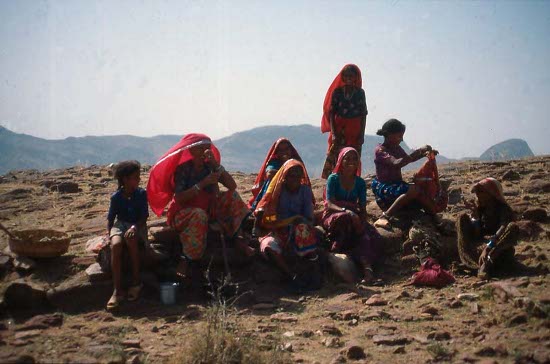
Women, Pushkar
I spent much of the next 3 days with Christophe before I finally took off for Jaipur and he went on a 3 day camel trek. We had meals of porridge, banana pancakes, pasta dishes, fried rice, pizzas, thalees, pakoras and fruit. Days were spent doing walks around nearby hills and desert. A small temple hill near the north of town, and a larger and more distant temple hill to the south-west, both afforded magnificent views of surrounding desert, especially at sunset. Another longer early-morning walk (too hot in the afternoon) was up a dry thorny ridge to the south of town, where we could look over the Ajmer Valley. We loitered in the breeze on the ridge-top for some time, as we watched a group of women in brightly coloured dress slowly make their way up the path from Ajmer. We greeted them at the top and conversed and photographed as best we could. Thirst eventually drove us back to town late morning.
My jaundice had virtually disappeared and I felt well, although I must have been thin as Changi. Diarrhoea persisted though, just live with it.
On 17 April I caught a 14.30 bus for the hot and noisy 3.5 hour trip to Jaipur. A rickshaw in Jaipur took me to the Jaipur Inn where I got a bed in a refreshingly air-cooled dormitory, and a filling vegetarian meal.
In one full day in Jaipur I saw all I wanted to see before heading to Delhi. The Hawa Mahal Observatory was reminiscent of that near Janpath in Delhi. The City Palace Museum exhibited a routine array of costumes, weapons and artwork. But one interesting weapon was a musket with a wavy - like a Kris dagger - barrel, somehow defying the laws of physics. North of the city were hills with imposing looking ramparts, but I didn't bother to get up there.
At 09.00 in the morning I caught a bus for the 5 hour trip to Delhi. The driver used his horn a lot, even for India, and a shrill piercing one it was too. This trip is where I learned to stuff tissues in my ears to block out some of the horn noise.
I'd now been in India over 3 months, living on India food or sometimes mediocre imitations of western food. But here in Delhi, near where I got of the bus at Connaught Place, was a real live western fast food outlet, in the form of a Wimpy hamburger restaurant. Even before finding a guest house, I was straight in there with my backpack ordering a large cheeseburger (mutton not beef), fries and chocolate shake. Hard to explain how much one misses this type of food after so long.
Only then did I get a map in the tourist office and find a 40 Rs bed in a sweaty dungeon in the Ringo Guest House. Delhi is one of the most expensive cities for travellers in India.
Here is where I have to do some investigation, planning and juggling to work out onward destinations. My hope has been to spend a bit more time in northern India, continue on to Pakistan, and through to Western China, returning to Canada from that country. The Pak embassy is closed until Monday, 4 days away. Kashmir looks to be to unstable for travel. News media suggested that there was rioting in Kashgar and it would be difficult to get into China from the west, but a contact with the Chinese Embassy didn't indicate problems there. I checked the Poste Restante a couple of times in Delhi. A very welcome letter arrived from my parents in Canada, to which I replied immediately. Also I got a telegram to call someone in Australia. I did so later, quite expensive at 50 Rs per minute for 13 minutes.
Heat here was oppressive; one day there was a brief rainstorm that lowered the temperature from 39 to 27 degrees within minutes. My runs were getting worse while in this city; maybe because I was eating more meat here, including hamburgers and Chinese food. The intestinal problems plus the heat made long walks an effort. I did some shorter walks around various districts, including Paharganj and the railway station, and another day a longer walk up to the crowded and bustling Chandri Chowk area of Old Delhi.
On Monday 23 April I caught an early morning bus to Shantipath and the Pakistan embassy. I could apply for my visa at 10.30, to be picked up at 13.00, which gave me some time to relax and read old newspapers in the nearby Australian Consulate. Thus I had my Pakistan visa, one more hurdle overcome.
Next day I caught a local bus up to the Interstate Bus Terminal in the north of the city, to arrange a night bus to Dharamsala in Himachal Pradesh. I had to fight off private ticket agents trying to sell me 160 Rs tickets, before waiting an hour in line at the government bus office for a 90 Rs ticket, leaving 22.00 tonight. Interestingly, signs were posted around the terminal advising bus passengers to look for explosive devices hidden under their seats. Back down-town I tanked up on food and water, packed up, and returned to the ISBT in the evening.
Waiting for departure, and later on the bus, I chatted with some very open and friendly Tibetan monks making the same journey. Despite soft seats, I slept little that night.
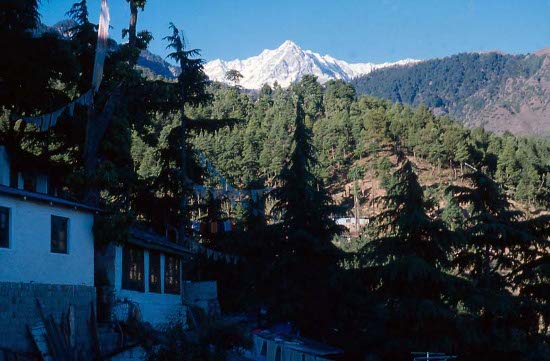
McLeod Ganj
We were in the long, ridge-top, typically Indian city of Dharamsala at 10.00. A small bus took us up the hill the hour or so to the cool, Tibetan-character suburb Mcleod Ganj. Here is a real travellers retreat; cool hill station, pleasant Tibetan-run hotels and restaurants, attractive walks and treks, farangs who stay forever, and the home of the Dali Lama.
Many Tibetans who have escaped from Tibet have settled here or are in transit, making for a significant "Free Tibet" sentiment and movement. Photos, pamphlets and video presentations are everywhere calling attention to the oppression of the Tibetans by Chinese. One movie was called "Red Flag Over Tibet" and gave some quite stirring portrayals of the suffering of the Tibetans, as well as highlighting the Tibetan influence on Dharamsala. I was amused by one backhander in the video about the Hindus, to the effect that "The beggars are here because they know where to find compassion".
It took some time checking mostly full accommodation to find a relatively expensive room in a guest house. Latrer I would move into a cheaper dorm bed in the more amiable Kalsang Guest House, where I could meet and hang out with other travellers.
Fabulous to be cool and relaxed again. I'd be here about 6 days and would love every minute. Food was good and not expensive; I dined well on Tibetan momos and thupkas, pseudo-western or Chinese dishes, and Indian fare. Small movie theatres, for a small fee, played videos of western movies; I attended a number of them to pass the time.
The hill where the Dali Lama lives is a gigantic Gompa featuring large numbers of prayer flags and well-maintained stones with inscribed and painted scripture. The great one himself was not at home the day I looked around there, but I heard he was to return another day, coming up in a vehicle from Dharamsala. I was there to see him that day with may others lining the road below the residence. Up came the motorcade with the smiling Dali Lama waving and greeting his followers, a remarkable sight.
I did several walks around and outside the village, either alone or with others. In a nearby village is the small Dal Lake, not to be confused with its namesake in Srinagar. This one was so thick and dirty that it looked like real dahl (lentil stew).
I walked a couple of times down the hill to Dharamsala, and took a bus back up, to try to organise transport back to Delhi, eventually getting a bus ticket for 22.00 on 1 May.
A 2 km walk to the east is a picturesque waterfall with cool water and lots of people swimming and washing clothes, tending goats and quarrying roof tiles. It was a good place to swim, sit and read.
One day I packed a lunch and walked up from McLeod Ganj to the snow line in the Dhauladhar ranges. It doesn't look that far away from town, but with stops it takes nearly 5 hours to get there. On a road at the start, the way degenerates to a rocky path up to the desolate ridge village of Triund, then a slow, slippery and tiring trudge up to a snow ridge at about 3000 m elevation. Cloud shrouded most of the mountain peaks, but had great views of the valley, town and plains below. At 15.00 I had to start back down to make it back shortly after 18.00, tired, aching, swollen ankles and a slight headache.
One evening a couple of us saw a performance of Tibetan song and dance. It looked to be mainly for locals rather than tourists, and there must have been close to 1000 people there.
On the bus back toward Delhi on the morning of 2 May, we saw close to a dozen vehicle accidents or breakdowns. Makes one nervous. In Delhi I moved back into Ringo Guest House, had lunch and spent considerable time organising train transport to Amritsar for 22.00 next day. After dinner, shower, washing clothes etc. it was nearly 23.00; a tiring day but I had to keep going to get everything done. Next day involved resting, packing up, buying books and magazines to read, eating, and making my way to the Old Delhi Train Station. I explored around the Old Delhi Bazaar until my pack hurt, and waited for the train to leave. My compartment was crowded with other travellers and Indians but I got a good sleep anyway.
In Amritsar at 07.00, I waited for a train connection to the Pak border. Met and talked to an American guy who had, like me, been stressed out with work and chucked it all in to travel. Also talked to an older Indian guy who'd travelled the world with the Merchant Marine. I was commenting to him how hot it was in the station and he said it wasn't really that bad. So I asked where was the hottest place he'd been to. He replied without hesitation, "Lightning Ridge, Australia". Amazing, he was right, that was the hottest place I'd ever been to as well.
The train to Lahore left at 09.30, arriving quickly at the border town of Attari. However, most of the rest of the day was spent passing through customs, waiting a few hours for the train to cross the border, and clearing Pakistan customs in Lahore. I didn't exit Lahore station until after 17.00.
I'd survived nearly 4 months in India, momentous ups and downs, and a totally unforgettable experience.
Pakistan
(Click for map)Here I was in Pakistan on 4 May. It didn't look all that different to India at this stage, but contrasts would come out in time. I changed some money in the station, working out to about 22 Pak Rs to the USD. Simple meals would be about 4 to 7 Rs each, depending on meat content. A room might cost 35 to 70 Rs.
I walked around quite some distance trying to find a bed, finally settling on a basic room with bath and a simple dahl-nan (that's lentils and tandoori bread) meal. I only stayed here overnight, catching the 10.20 train next morning for Rawalpindi. Meanwhile I had chickpeas and rice for breakfast and a beefburger (yes, real beef, no Hindus here) for a snack.
I was lucky to get a seat corner on the very crowded train. I tried to listen to a music tape on my Walkman, but it was too enticing to a local youth, who politely coerced me into lending it to him for a while. It was harvest time on the wheat fields as we sped past, farmers cutting the crops with sickles and putting them through small threshers. Farther on the land deteriorated to small hills, gullies and cliffs, with goats foraging amongst the acacias.
In Rawalpindi after 17.00, I had difficulty finding a hotel room, all alleged to be full. I definitely felt that I was being discriminated here, they don't seem to accept foreigners. Finally found a hotel that accepted me, and had a room with bath and fan and balcony.
I'd be in Rawalpindi and Islamabad for 2 or 3 days trying to work out where to go next. I caught one of those lavishly decorated and painted local buses for the few km to Islamabad. The capital city is one of those purpose-built capitals, spread out and tree-lined. Everything is too far apart to walk. I had to take a taxi to the Chinese Embassy to find out about travel there. As expected, they have come up with a convenient excuse for closing the border i.e. landslides on the highway, to cover up the Kashgar riots. So that direction was not an option for me, and I would have to re-think my plans to go to Canada via China. Travel west via Afghanistan or Sind/Iran was problematic or impossible. I finally decided to fly straight back to Canada by the end of the month.
Back in Rawalpindi, it took all afternoon next day to arrange a flight to Canada. I wound up with a ticket from a travel agent, Pakistan Airlines to Toronto, leaving on 29 May, for 16900 Rs. So now I have 22 days in which to look around Pakistan.
On the morning of 8 May I took a mini-bus to the suburb of Raja Bazaar, and another to Perawahi where the main bus station was. An adequately comfortable 17 Rs bus left at 09.40 for a 3 hour trip to the NW Frontier Province city of Peshawar, gateway to the Khyber Pass.
I'd been here briefly in 1977, on the way to Afghanistan, but would have time now for a better look. I found a single fan room in the Khyber Hotel and an enormous lunch of chicken masala, chicken tikka, rice, nan, salad and Sprite. The city looked more built-up than it had been 13 years ago.
My next destination was to be Chitral Valley in the north toward the Hindu Kusch. The road was said to be closed though (more landslides?) and the only way was to fly. After a day or two of trying I managed to get a plane flight to Chitral for 14 May for 365 Rs.
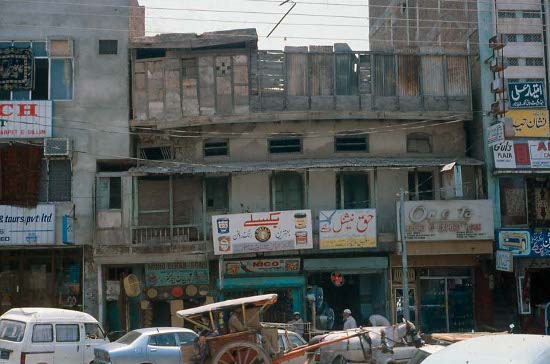
Street, Peshawar
So, 3.5 days to look around Peshawar and environs. This place is predominantly Pashtun in nature and has its rough edges. These were the people who, according to Kipling, had an "interview" with the British over 100 years ago, resulting in many casualties. They beat the British then, and the Russians again more recently. I wasn't going to mess with them.
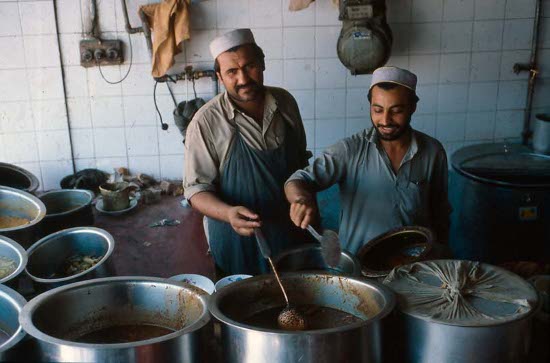
Kitchen, Peshawar
I explored around the Old City, Khyber Bazaar area and Qissa Kawanis. Shops were full of fabrics, jewellery, carpets, spices, fruit, dry goods and spices. I stopped at a street restaurant for a kebab, stew and nan lunch. This food is delicious the first 2 or 3 times, but one gets sick of it pretty fast, and it's greasy nature didn't help my recent hepatitis.
The Peshawar Museum had a good collection of statuary and reliefs from Buddhist ruins, that religion being big here in pre-Islamic times.
It's so hot here that we spend much of the day in a heat-induced torpor, writing postcards or reading in a park or just lying around. I tried the trick of pouring water all over the floor in my room in an attempt to induce some evaporative cooling, but it wasn't particularly effective. It takes hours to get to sleep at night.
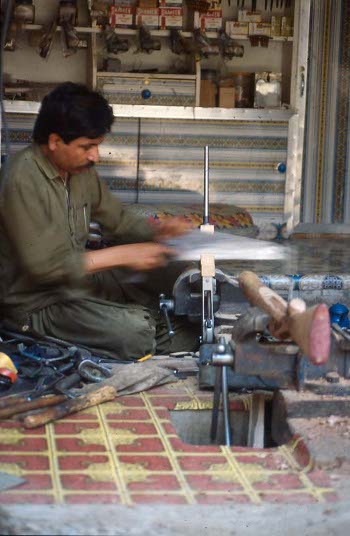
Gunsmith, Darra
One morning another couple and myself took a bus for an hour or so south for a day trip to the town of Darra. Here's the Wild East, a town built on weapons manufacture and trade. There are about 1200 gun manufacturers and shops, hand making everything from pen guns to rocket launchers. Streets and malls are lined with shops selling copies of well know weapons; handguns, Kalashnikovs, .303's, Uzis, HK's, sporting rifles, holsters and knives. Gunshots reverberated all over; as we walked down the street someone would come out of a shop to test-fire a weapon right next to us.
One shop-owner invited us out to the edge of town to fire off a few rounds from a 5.65 Kalakov and a .30 Mauser handgun, charging us a fee for the ammunition. Quite a buzz. I bought a .25 cal pen gun as a souvenir, but didn't keep it long as they are highly illegal in most countries. But it all was a unique experience anyway.
One evening a group of us went for a Chinese meal at the Hong Kong Restaurant. I think Pakistan has the worst Chinese food in the world, expensive and almost totally unlike anything Chinese.
On 14 May three of us were up at 05.15 and on a rickshaw to the airport for the 07.00 flight to Chitral. After a very lengthy and involved security check, we were on the F-27 for a 45 minute flight. All I remember about the flight was that the mountain pass was so high that we didn't clear it by much.
Chitral is a small town in a beautiful green valley, a grey river flowing below and snow-capped peaks surrounding. It's at an altitude of nearly a mile and is much cooler than Peshawar, but can still get hot in the sun.
We got rooms in the Trich Mir Hotel, registered with the police (you have to do that a lot in these remote places), looked around the town and the little "fort" with its walls and battlements, and rested in the room. Toilets here were built on stilts over the river, saves having to dig a hole or clean it up.
We knew that the nearby Kalash valleys were having their Kafir Spring Festival at this time of year. So next morning the three of us caught a bus south to the village Ayun, and then a crowded jeep west up one of the valleys to the Kalash village Bumburet. We stopped for another police check and to pay a tax of 50 Rs to enter the valley. The road was so rough and narrow that the other couple opted to walk the last 12 km.
I arrived at Bumburet and the Peace Hotel about noon, and got a share room with a French guy. It was good value, 50 Rs per night including boringly repetitive but adequate vegetarian meals. The valley is smaller than Chitral, with a swift-flowing river, but quiet, pretty and tranquil. The festival is on yesterday, today and tomorrow. As the crops were just starting to grow, I believe that it has an aspect of spring planting celebration.
This is an enigmatic place and inhabitants. The Kafir Kalash (I think meaning black infidels) do not look Asian at all, more European in features. They have their own pre-Islamic religion, and are reputed to be one of the few peoples around who never converted. Apparently Moslems are not allowed to attend the festival.
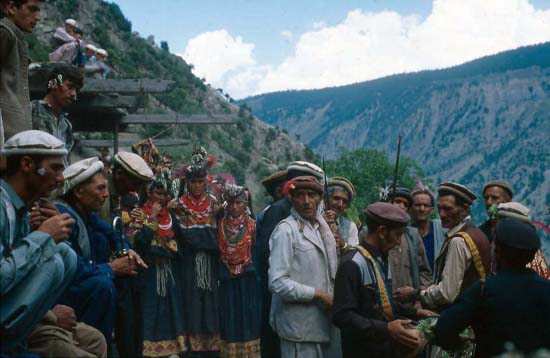
Kalash Dance, Bumburet
We watched some of the festivities in the afternoon; simple drum beat, women in fancy costumes and heavily ornate jewellery (said to be everyday wear here), graceful rhythmic dancing in 3 or 4 people or in long lines. All dreamily captivating. The next and final day of the festival started with a similar routine. Finally they went into a wild free-for-all. Women danced with children on shoulders. Men and women separated and came together. Dancers held onto one-another with rope loops; tugging, bumping together, falling, playfully trying to keep one another in line with switches and verbally abusing one another. I couldn't get over how lucky I was to be here at the right time.
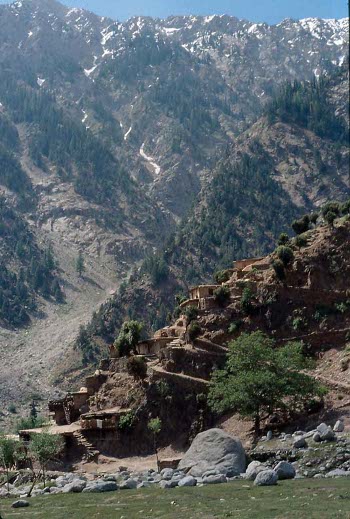
Bumburet valley
Apart from the festival, I explored up and down the valley and surrounding hills, there's a lot to see and it's beautiful country. I could walk up side valleys to pine forest and read or enjoy mountain views, check out small rustic villages perched on hillsides, or just relax by the river. Steep upper slopes keep the walking range within a few km. Women worked in the fields in the same ornate dress and jewellery as at the festival; it really is everyday wear. One morning I packed a lunch and walked with a couple of Danes up an upstream valley. We progressed up gentle slopes past villages, fields, pastures and small side glaciers, until we attained a quite large glacier beyond which the valley steepened sharply. Stood on the ice and took in the views, and back home by 15.00.
After about 5 days with the Kalash, I started back to Chitral. Couldn't find a jeep in Bumburet, so took the pleasant, scenic and invigorating walk down the valley to Ayun. A cup of chai and a jeep got me back to Chitral and the Trich Mir Hotel by 13.00.
Next destination was uncertain. Could I get north and east to Shandur Pass and through to Gilgit, or would I be forced to fly back to Peshawar? With other travellers of the same persuasion, I asked at the tourist office, and at the cargo jeep stand, about transport to Gilgit, but everyone has a different answer and we aren't even sure that the pass is open.
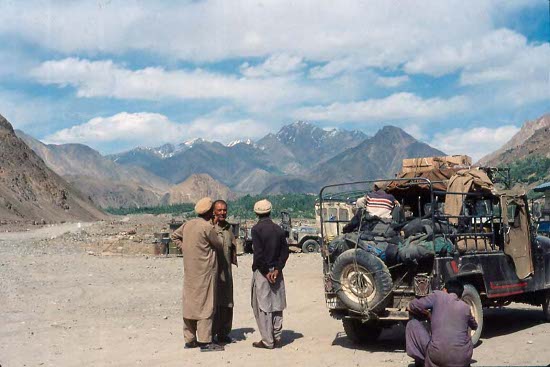
Chitral Valley
We decided that we just had to find a jeep and just see how far it could take us. At 09.00 next day, 21 May, four of us negotiated a cargo jeep (100 Rs each) up the valley and across to the village Mastuj, gateway to the Shandur Pass. I found a place to sit on the back over the spare tire for the long bouncy 10-hour ride. Up a rocky road along a fast flowing river and past stark mountains, we encountered several villages, one for lunch of mutton stew and nan, and even a few fuel stations. One flat tire caused the usual delay. Later in the day I was getting dry and thirsty and seemed to be getting flu or something; every km seemed an eternity.
Near dark we were in the small group of mud-brick huts called Mastuj. We got beds in a dorm and I cleaned up and went straight to bed, weak and sore all over.
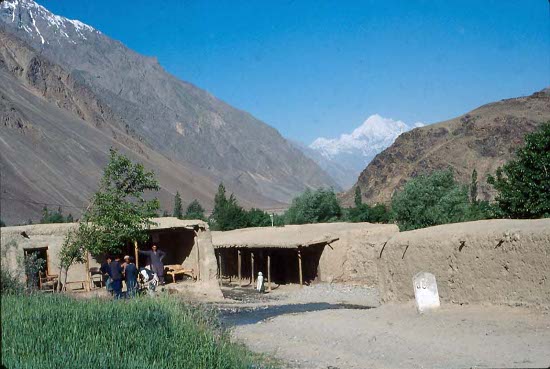
Downtown Mastuj
Next day I felt better. We couldn't find any onward transport, so I explored around the village, rested and read. Mastuj is situated on a flat alluvium above a river confluence, a quiet picturesque and very un-touristed village. The people, especially the kids, are curious and watchful, good for a while but hard to get away from them. About noon I found a quiet place to sit on grass near a hill and read. An older woman came out from a nearby compound and waved at me. I couldn't tell whether she was trying to shoo me away or invite me in, so I took a chance and came into the compound with her. No English was spoken but we had a wonderful time. She made me tea, introduced her daughter and two grandchildren, had lunch of chapati and curd, shared my raisins and nuts, and chatted as best we could. I was surprised that I could enter a private home of a Moslem family without the man present, but it does fit with the intrinsically hospitable nature of the religion.
After one lay day, we must get out somehow. The following morning four of us couldn't find transport in the village, so we hitched out to the road junction and bridge. At 11.30, after about 2 hours wait, we finally found a passenger jeep going straight to Gilgit, and negotiated a price of 200 Rs each. We were saved.
Today was a much more comfortable trip than 2 days ago. Great views of peaks and valleys accompanied us up to the flat grassy saddle of the (9000 ft I think) Shandur Pass. A small lake nestles in desolate uninhabited surroundings.
Down from the pass in Gilgit direction, the valley quickly becomes less remote and passes through numerous villages. On the way we picked up a German traveller Herbert. I would later go on to Hunza valley with him and we would keep in touch and travel together many times in the future. Our jeep stopped in the village Gupis for the night at 21.30, beds and meals in a nice guest house there.
We were roused at 05.30 next day for breakfast, and on the road at 06.30. There is so much scenery here, spectacular green valleys and stark mountainsides, that one becomes complacent about it. There are no trees on the mountains, but I'm not sure whether it was deforestation or just dry climate.
At 12.30 on 24 May we were in the large town Gilgit on the junction of the Gilgit and Hunza Rivers. Here is the gateway to Hunza and the Karakorams.
I had 6 days before my flight, and wasn't sure what I had time for now. Go up the Hunza Valley or straight back to Rawalpindi? There wasn't a lot to do or see in Gilgit.
As I was turning it over in my head, I went over to the nearby polo ground about 16.30 and watched the match. I believe that polo originated around here somewhere. It all looked somewhat rough and ready but hard to tell as it's the only one I've seen.
Next day I decided to go with others up to Karimabad in the Hunza Valley for a couple of days. That should still give me time to get back to Pindi before the flight.
We boarded a bus at 11.00, and were headed up the Karakoram Highway, paved and a lot smoother and faster than the tracks we were on the last few days. We had to stop once or twice though to watch for landslides in windy/dusty areas; at one point small rocks were rolling down the slope and onto the road. We were in Karaimabad in 4 hours.
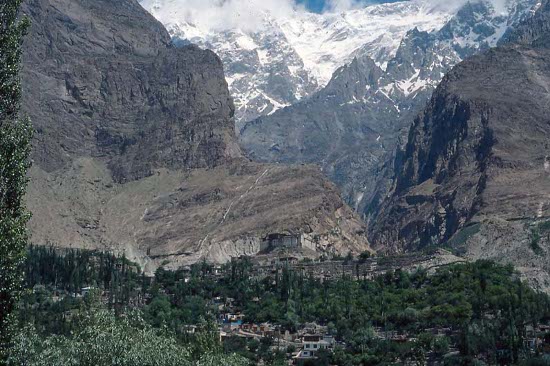
Karimabad
Karimabad is a pleasant mostly mud/stone/wood village perched on a slope above the valley. Two 600 year old forts Baltit and Altit perch precariously on peaks overlooking the villages. There were several hotels, restaurants, travellers and trekking opportunities.
Herbert and I got a room and an early dinner of mutton curry, dahl, nan and tea. Slept well.
In the morning three of us walked up to the Baltit Fort above the village. It's compact and reasonably well preserved, with many intact rooms inside and great views of surrounding peaks from the rooftop. Above the fort and town, a steep climb took us to greater viewpoints. A careful walk along a narrow, slightly dangerous and very unnerving water channel took us to the bottom of Ultar Glacier, with its black ice and dirty run-off water.
Back in town, we were getting sick of Pak food and decided to try our own meal. We bought fixings for a spaghetti dinner and commandeered the hotel kitchen to prepare it. Owing to a surplus of cooks and an unfamiliar kitchen the whole effort was a disaster; the pasta porridge-like and the sauce bland. We ate it and a salad anyway.
Next morning we were up at 05.00 to catch the sunrise on the snow-covered peaks. The others took a walk up around the glacier, but a cold and intestinal problems kept me home. I rested, read and posted cards. Later I went to the local hospital for my runs. What a weird place, just a building with a central hallway and rooms on each side. Only one room was occupied, with a couple of people helping an elderly woman. No doctor was around. I went out to ask a young guy washing a car, and he said he could help me. For the absurd price of 1 rupee, he gave me a script for some Flagyl and Furafyl, which I later picked up at a local pharmacy shop.
Next day Herbert and I were up at 05.00 to catch the bus back to Gilgit, only a 2.5 hour trip from which we could watch the sunrise over the mountains.
I think all the greasy food was giving me a slight relapse of my hepatitis, I was again weak and jaundiced with no appetite. I tried eating fruit to settle my stomach, and rested in Herbert's room (he was on his way to Skardu while I would take the bus to Pindi at 13.00).
The bus trip was cramped and terrible, unable to sleep. Down we went through more mountainous highway. The bus driver had the habit of stopping and shaking hands with everyone he knew. It stopped for no apparent reason for 2 hours at one police post. We continued next morning through flat green landscape to Pirawadhi at 06.45. Mini-buses took me to my hotel district in Rawalpindi, where I found a room in the Al Khalil Hotel. The heat was intense back here in the lowlands, and I dehydrated as fast as I rested in the room, even with the fan full bore.
I confirmed my flight to Canada tomorrow. Later I ran into the two Danes from the Kalash Valley. The political situations seem to be deteriorating; they said that India was no longer giving visas in Pakistan, and they would have to fly to Nepal.
In the evening I went to the telegraph office to phone Mom in Canada to say I was on the way there. It was well I did. She asked me why I was phoning, I told her, and she said "So you haven't heard?". My father had passed away a few days earlier and I had missed the funeral. Terrible news. Obviously I didn't sleep well that night.
30 May was my last day in Pakistan. I still had slight jaundice, the diarrhoea pills were not yet working, and I was reeling from the news of my father. But I had to forge on. I used up most of my remaining cash on a pair of shoes and souvenirs for my family.
At 16.00 I checked out of the hotel, negotiated the quiet hot lazy streets onto mini-buses to the airport, and waited for the flight. The airport was mostly open-air and not air-conditioned, making it a hot wait. I read and sweated until 20.00, when I passed through the extensive security checks. At last it was a bit cooler inside here. I chatted with a Pakistani from Montreal who was thinking of returning to Pakistan to sell used cars.
We were airborne late, just after midnight. I do not normally notice a lot of difference amongst airlines, but Pakistan International Airlines looked like not much more than a jumped-up local bus company. I call them "Ins Allah" Airlines because they insert that convenient indemnity clause into their announcements whenever they are about to land or whatever. Interaction from staff is minimal, the speakers are inaudible, my reading light was controlled by someone else's switch, and it was hard to get adequate fluids. The classical music channel had only Leonora Overture and New World. We stopped in Karachi, Damascus, Frankfurt and New York before Toronto, but could only depart the aircraft at NY, where we paid for the privilege by subjection to a dog search. I arrived in Toronto at 16.00 on May Day, visiting relatives there for a few days before continuing on to my Manitoba home and my grieving Mom.
This whole trip took 7 months, not as long as the nearly 9 months in 1976-77. But the 4.5 months enduring the tremendous ups and downs of India and Pakistan made this trip in many ways more intense. I was often frustrated, stressed, deprived, uncomfortable or sick. Contrast that to the spectacular sights of the Langtang Valley, Madurai Temple or Karimabad, and the peace and tranquillity of Soppong, Kodaikanal, Varkala or the Kalsah valley, and it's an unforgettable combination. It wouldn't be my last encounter with this diverse and enigmatic part of the earth.
